service CITROEN C5 AIRCROSS 2020 Handbook (in English)
[x] Cancel search | Manufacturer: CITROEN, Model Year: 2020, Model line: C5 AIRCROSS, Model: CITROEN C5 AIRCROSS 2020Pages: 292, PDF Size: 8.59 MB
Page 2 of 292
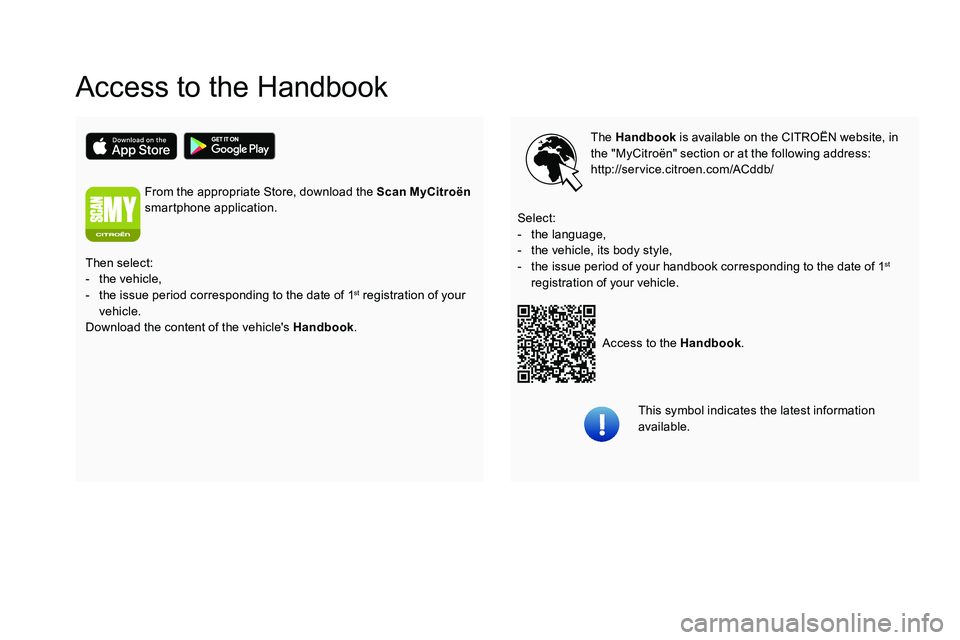
Access to the Handbook
The Handbook is available on the CITROËN website, in
the "MyCitroën" section or at the following address:
http://service.citroen.com/ACddb/
Access to the Handbook .
Select:
-
t
he language,
-
t
he vehicle, its body style,
-
t
he issue period of your handbook corresponding to the date of 1
st
registration of your vehicle.
Then select:
-
t
he vehicle,
-
t
he issue period corresponding to the date of 1
st registration of your
vehicle.
Download the content of the vehicle's Handbook .
From the appropriate Store, download the Scan MyCitroën
smartphone application.
This symbol indicates the latest information
available.
Page 9 of 292

7
Limit the causes of excess
consumption
Spread loads throughout the vehicle; place
the heaviest items at the back of the boot, as
close as possible to the rear seats.
Limit the loads carried in the vehicle and
reduce wind resistance (roof bars, roof rack,
bicycle carrier, trailer, etc.). Preferably, use
a roof box.
Remove roof bars and roof racks after use.
At the end of winter, remove snow tyres and
refit your summer tyres.
Obser ve the recommendations on
maintenance
Check the tyre pressures regularly, when cold,
referring to the label in the door aperture,
driver's side.
Carry out this check in particular:
-
b
efore a long journey,
-
a
t each change of season,
-
a
fter a long period out of use.
Do not forget the spare wheel and the tyres on
any trailer or caravan.
Have your vehicle ser viced regularly (engine
oil, oil filter, air filter, cabin filter, etc.) and
obser ve the schedule of operations in the
manufacturer's service schedule. When filling the tank, do not continue after the
3
rd cut-off of the nozzle to avoid over flow.
At the wheel of your new vehicle, it is only
after the first 1,900
miles (3,000 kilometres)
that you will see the fuel consumption settle
down to a
consistent average.
With a
BlueHDi Diesel engine, if the SCR
system is faulty, your vehicle becomes
polluting. Visit a CITROËN dealer or
a
qualified workshop as soon as possible to
bring your vehicle's nitrogen oxides emissions
back in line with regulations.
.
Eco-driving
Page 10 of 292
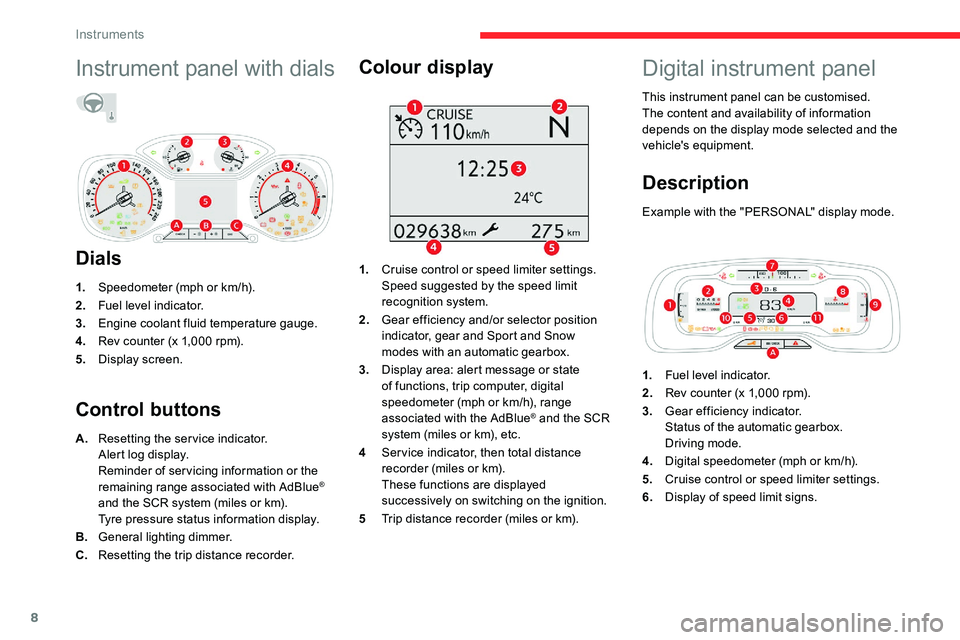
8
Instrument panel with dials
Dials
1.Speedometer (mph or km/h).
2. Fuel level indicator.
3. Engine coolant fluid temperature gauge.
4. Rev counter (x 1,000
rpm).
5. Display screen.
Control buttons Colour display
1.
Cruise control or speed limiter settings.
Speed suggested by the speed limit
recognition system.
2. Gear efficiency and/or selector position
indicator, gear and Sport and Snow
modes with an automatic gearbox.
3. Display area: alert message or state
of functions, trip computer, digital
speedometer (mph or km/h), range
associated with the AdBlue
® and the SCR
system (miles or km), etc.
4 Ser vice indicator, then total distance
recorder (miles or km).
These functions are displayed
successively on switching on the ignition.
5 Trip distance recorder (miles or km).
A.
Resetting the service indicator.
Alert log display.
Reminder of servicing information or the
remaining range associated with AdBlue
®
and the SCR system (miles or km).
Tyre pressure status information display.
B. General lighting dimmer.
C. Resetting the trip distance recorder.
Digital instrument panel
This instrument panel can be customised.
The content and availability of information
depends on the display mode selected and the
vehicle's equipment.
Description
Example with the "PERSONAL" display mode.
1.Fuel level indicator.
2. Rev counter (x 1,000
rpm).
3. Gear efficiency indicator.
Status of the automatic gearbox.
Driving mode.
4. Digital speedometer (mph or km/h).
5. Cruise control or speed limiter settings.
6. Display of speed limit signs.
Instruments
Page 16 of 292
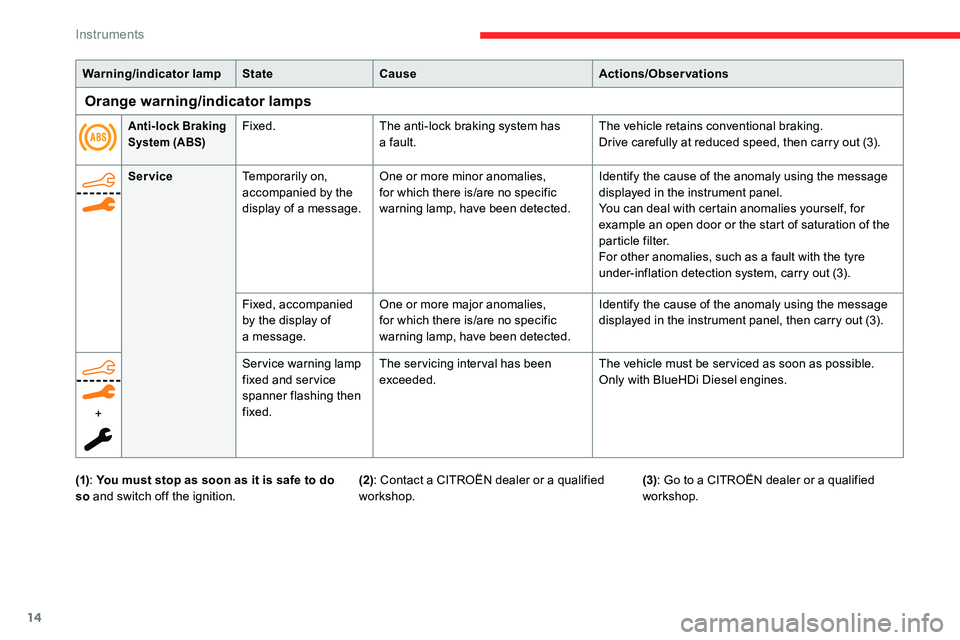
14
Anti-lock Braking
System (ABS)Fixed.The anti-lock braking system has
a
fault. The vehicle retains conventional braking.
Drive carefully at reduced speed, then carry out (3).
Warning/indicator lamp
StateCause Actions/Observations
Service Temporarily on,
accompanied by the
display of a
message. One or more minor anomalies,
for which there is/are no specific
warning lamp, have been detected. Identify the cause of the anomaly using the message
displayed in the instrument panel.
You can deal with certain anomalies yourself, for
example an open door or the start of saturation of the
particle filter.
For other anomalies, such as a
fault with the tyre
under-inflation detection system, carry out (3).
Fixed, accompanied
by the display of
a
message. One or more major anomalies,
for which there is/are no specific
warning lamp, have been detected. Identify the cause of the anomaly using the message
displayed in the instrument panel, then carry out (3).
+ Service warning lamp
fixed and ser vice
spanner flashing then
fixed.
The servicing interval has been
exceeded.
The vehicle must be ser viced as soon as possible.
Only with BlueHDi Diesel engines.
(1) : You must stop as soon as it is safe to do
so and switch off the ignition. (2): Contact a
CITROËN dealer or a qualified
workshop. (3)
: Go to a
CITROËN dealer or a qualified
workshop.
Orange warning/indicator lamps
Instruments
Page 21 of 292

19
Under-inflationFixed, accompanied
by an audible signal
and a
message.The pressure in one or more wheels
is too low.
Check the pressure of the tyres as soon as possible.
Reinitialise the detection system after adjusting the
pressure.
+ Under-inflation
warning lamp flashing
then fixed and
Service warning lamp
fixed.The system is faulty: tyre pressures
are no longer monitored.
Under-inflation detection is no longer monitored.
As soon as possible, check the pressure of the tyres
and carry out (3).
Warning/indicator lamp
StateCause Actions/Observations
Diesel engine
pre-heating Fixed.
The period of
illumination depends
on the climatic
conditions. The ignition is on.
Wait until the warning lamp goes off before starting.
If the engine does not start, switch the ignition off and
then on, wait until the lamp goes off again, then start
the engine.
Front passenger
airbag (ON) Fixed.
The front passenger airbag is
activated.
The control is in the "ON" position. In this case, do NOT install a "
rearward facing"
child seat on the front passenger seat – risk of
serious injury!
Front passenger
airbag (OFF) Fixed.
The front passenger airbag is
deactivated.
The control is in the "OFF" position. You can install a "rear ward facing" child seat, unless
there is a
fault with the airbags (Airbags warning lamp
o n).
Airbags Fixed. One of the airbags or seat belt
pretensioners is faulty. Carry out (3).
1
Instruments
Page 28 of 292
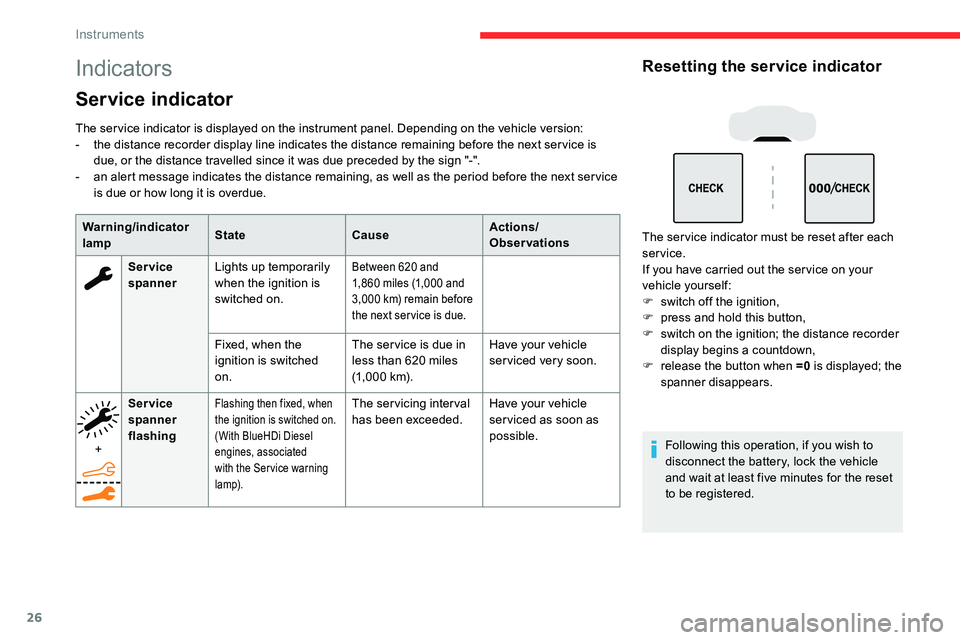
26
Indicators
Service indicator
The ser vice indicator is displayed on the instrument panel. Depending on the vehicle version:
- t he distance recorder display line indicates the distance remaining before the next ser vice is
due, or the distance travelled since it was due preceded by the sign "-".
-
a
n alert message indicates the distance remaining, as well as the period before the next ser vice
is due or how long it is overdue.
Warning/indicator
lamp State
CauseActions/
Observations
Ser vice
spanner Lights up temporarily
when the ignition is
switched on.
Between 620 and
1 ,860 miles (1,000 and
3,000
km) remain before
the next ser vice is due.
Fixed, when the
ignition is switched
on. The ser vice is due in
less than 620
miles
(1,000
km).Have your vehicle
serviced very soon.
+ Ser vice
spanner
flashing
Flashing then fixed, when
the ignition is switched on.
(With BlueHDi Diesel
engines, associated
with the Ser vice warning
lamp).The servicing interval
has been exceeded.
Have your vehicle
ser viced as soon as
possible.
Resetting the service indicator
The ser vice indicator must be reset after each
service.
If you have carried out the ser vice on your
vehicle yourself:
F
s
witch off the ignition,
F
p
ress and hold this button,
F
s
witch on the ignition; the distance recorder
display begins a
countdown,
F
r
elease the button when =0 is displayed; the
spanner disappears.
Following this operation, if you wish to
disconnect the battery, lock the vehicle
and wait at least five minutes for the reset
to be registered.
Instruments
Page 29 of 292

27
Retrieving the service
information
You can access the ser vice information at any
time in the instrument panel.The distance indicated (in miles or
kilometres) is calculated according to the
distance covered and the time elapsed
since the last ser vice.
The alert may be triggered close to a
due
date.
F
P
ress this button to temporarily display the
service information.
Engine oil level indicator
(Depending on version.)
On versions fitted with an electric oil level
indicator, the state of the engine oil level is
displayed in the instrument panel for a
few
seconds after switching the ignition on, after
the ser vicing information, in the form of
messages. The level read will only be correct if the
vehicle is on level ground and the engine
has been off for more than 30
minutes.
Low oil level
This is indicated by the display of a message
p rompting you to top up, accompanied by the
Service warning lamp and an audible signal.
If the low oil level is confirmed by a
check using
the dipstick, the level must be topped up to
avoid damage to the engine.
For more information on Checking levels ,
refer to the corresponding section.
Oil level indicator fault
This is signalled by the display of the " Oil
level measurement invalid " message in the
instrument panel.
Contact a
CITROËN dealer or a qualified
workshop. In the event of a
fault with the electric
indicator, the oil level is no longer
monitored.
If the system is faulty, you must check the
engine oil level using the manual dipstick
located under the bonnet.
For more information on Checking levels ,
refer to the corresponding section.
Engine coolant temperature
gauge
With the engine running:
- i n zone A , the temperature is correct,
-
i
n zone B , the temperature is too high; the
associated warning lamp and the central
STOP warning lamp come on in red in the
instrument panel, accompanied by the
display of a
message and an audible signal.
1
Instruments
Page 50 of 292
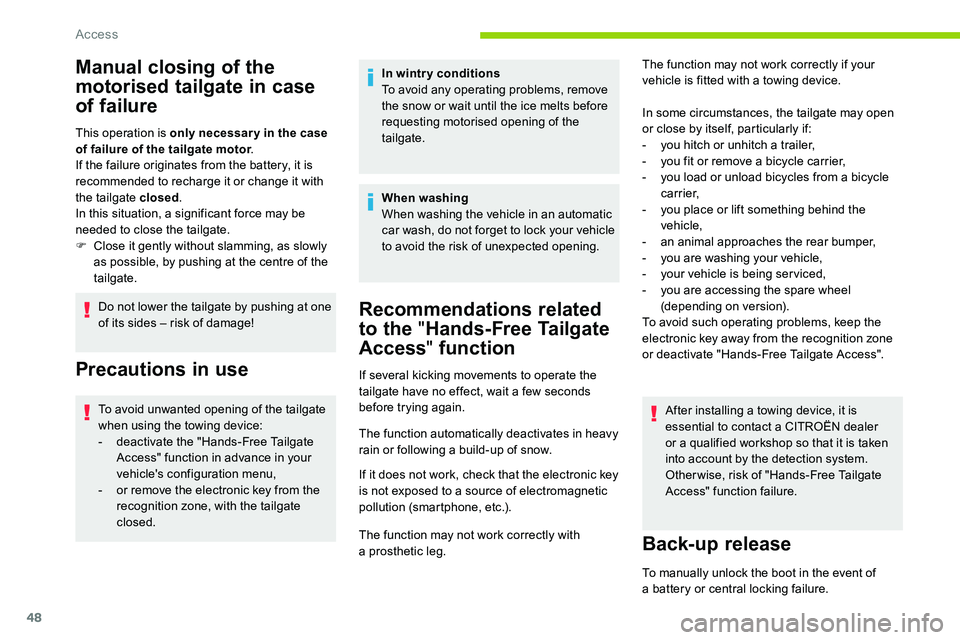
48
Manual closing of the
motorised tailgate in case
of failure
This operation is only necessar y in the case
of failure of the tailgate motor.
If the failure originates from the battery, it is
recommended to recharge it or change it with
the tailgate closed .
In this situation, a significant force may be
needed to close the tailgate.
F
C
lose it gently without slamming, as slowly
as possible, by pushing at the centre of the
tailgate.
Do not lower the tailgate by pushing at one
of its sides – risk of damage!
Precautions in use
To avoid unwanted opening of the tailgate
when using the towing device:
-
d
eactivate the "Hands-Free Tailgate
Access" function in advance in your
vehicle's configuration menu,
-
o
r remove the electronic key from the
recognition zone, with the tailgate
closed. In wintry conditions
To avoid any operating problems, remove
the snow or wait until the ice melts before
requesting motorised opening of the
tailgate.
When washing
When washing the vehicle in an automatic
car wash, do not forget to lock your vehicle
to avoid the risk of unexpected opening.
Recommendations related
to the "
Hands-Free Tailgate
Access " function
If several kicking movements to operate the
tailgate have no effect, wait a
few seconds
before trying again.
The function automatically deactivates in heavy
rain or following a
build-up of snow.
If it does not work, check that the electronic key
is not exposed to a
source of electromagnetic
pollution (smartphone, etc.).
The function may not work correctly with
a
prosthetic leg. The function may not work correctly if your
vehicle is fitted with a
towing device.
In some circumstances, the tailgate may open
or close by itself, particularly if:
-
y
ou hitch or unhitch a trailer,
-
y
ou fit or remove a bicycle carrier,
-
y
ou load or unload bicycles from a bicycle
c a r r i e r,
-
y
ou place or lift something behind the
vehicle,
-
an
animal approaches the rear bumper,
-
y
ou are washing your vehicle,
-
y
our vehicle is being serviced,
-
y
ou are accessing the spare wheel
(depending on version).
To avoid such operating problems, keep the
electronic key away from the recognition zone
or deactivate "Hands-Free Tailgate Access".
After installing a towing device, it is
essential to contact a
CITROËN dealer
or a
qualified workshop so that it is taken
into account by the detection system.
Other wise, risk of "Hands-Free Tailgate
Access" function failure.
Back-up release
To manually unlock the boot in the event of
a battery or central locking failure.
Access
Page 92 of 292
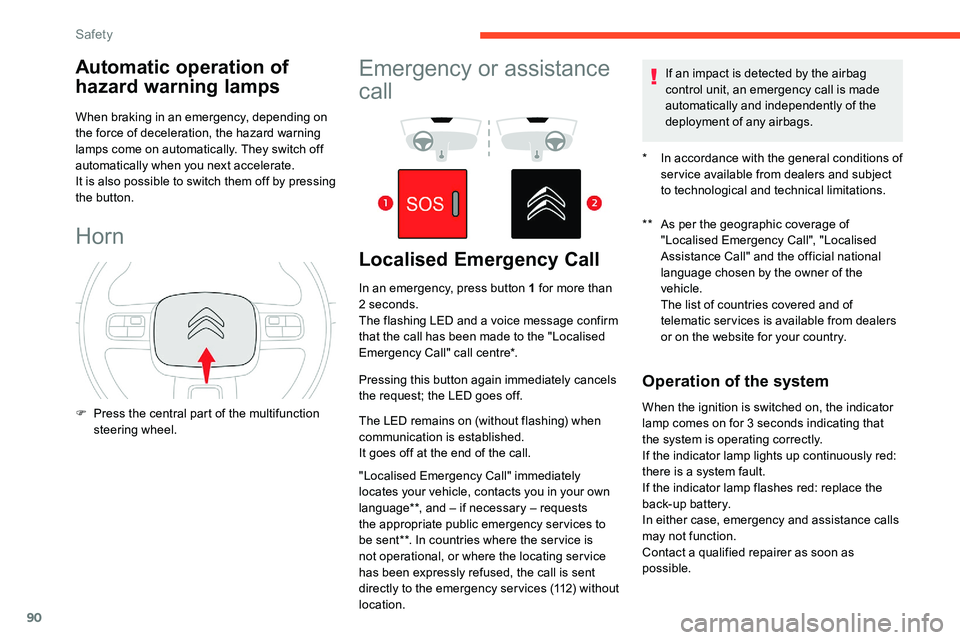
90
Automatic operation of
hazard warning lamps
When braking in an emergency, depending on
the force of deceleration, the hazard warning
lamps come on automatically. They switch off
automatically when you next accelerate.
It is also possible to switch them off by pressing
the button.
HornEmergency or assistance
call
Localised Emergency Call
* In accordance with the general conditions of
service available from dealers and subject
to technological and technical limitations.
**
A
s per the geographic coverage of
"Localised Emergency Call", "Localised
Assistance Call" and the official national
language chosen by the owner of the
vehicle.
T
he list of countries covered and of
telematic services is available from dealers
or on the website for your country.
In an emergency, press button 1
for more than
2
seconds.
The flashing LED and a
voice message confirm
that the call has been made to the "Localised
Emergency Call" call centre*.
Pressing this button again immediately cancels
the request; the LED goes off.
The LED remains on (without flashing) when
communication is established.
It goes off at the end of the call.
"Localised Emergency Call" immediately
locates your vehicle, contacts you in your own
language**, and – if necessary – requests
the appropriate public emergency services to
be sent**. In countries where the ser vice is
not operational, or where the locating ser vice
has been expressly refused, the call is sent
directly to the emergency services (112) without
location. If an impact is detected by the airbag
control unit, an emergency call is made
automatically and independently of the
deployment of any airbags.
Operation of the system
F Press the central part of the multifunction
steering wheel. When the ignition is switched on, the indicator
lamp comes on for 3
seconds indicating that
the system is operating correctly.
If the indicator lamp lights up continuously red:
there is a
system fault.
If the indicator lamp flashes red: replace the
back-up battery.
In either case, emergency and assistance calls
may not function.
Contact a
qualified repairer as soon as
possible.
Safety
Page 93 of 292
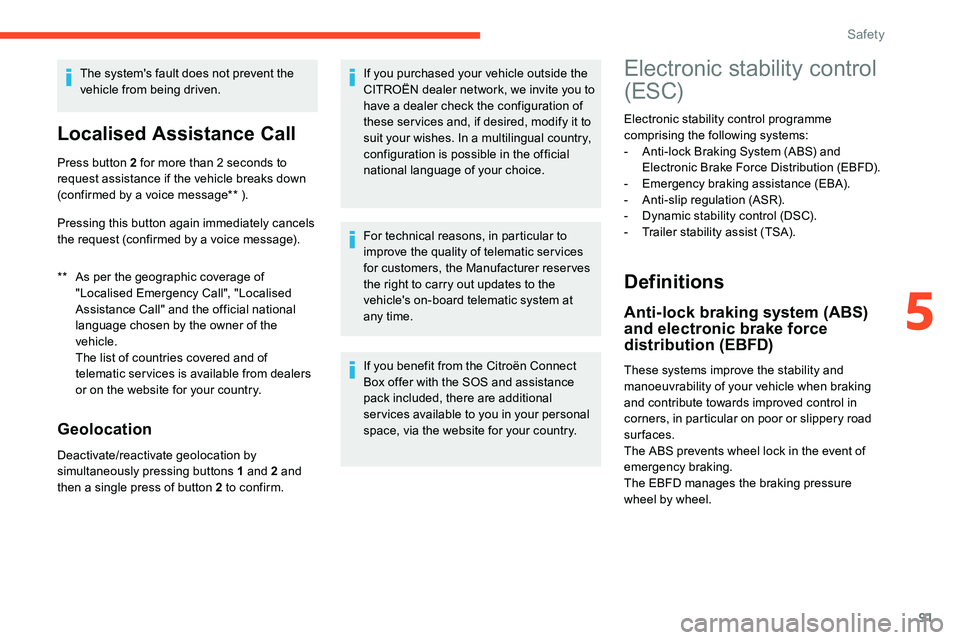
91
The system's fault does not prevent the
vehicle from being driven.
Localised Assistance Call
** As per the geographic coverage of "Localised Emergency Call", "Localised
Assistance Call" and the official national
language chosen by the owner of the
vehicle.
T
he list of countries covered and of
telematic services is available from dealers
or on the website for your country.
Press button 2
for more than 2 seconds to
request assistance if the vehicle breaks down
(confirmed by a voice message** ).
Pressing this button again immediately cancels
the request (confirmed by a voice message).
Geolocation
Deactivate/reactivate geolocation by
simultaneously pressing buttons 1
and 2 and
then a
single press of button 2 to confirm.If you purchased your vehicle outside the
CITROËN dealer network, we invite you to
have a
dealer check the configuration of
these ser vices and, if desired, modify it to
suit your wishes. In a multilingual country,
configuration is possible in the official
national language of your choice.
For technical reasons, in particular to
improve the quality of telematic ser vices
for customers, the Manufacturer reserves
the right to carry out updates to the
vehicle's on-board telematic system at
any time.
If you benefit from the Citroën Connect
Box offer with the SOS and assistance
pack included, there are additional
ser vices available to you in your personal
space, via the website for your country.
Electronic stability control
(ESC)
Electronic stability control programme
comprising the following systems:
-
A
nti-lock Braking System (ABS) and
Electronic Brake Force Distribution (EBFD).
-
E
mergency braking assistance (EBA).
-
A
nti-slip regulation (ASR).
-
D
ynamic stability control (DSC).
-
T
railer stability assist (TSA).
Definitions
Anti-lock braking system (ABS)
and electronic brake force
distribution (EBFD)
These systems improve the stability and
manoeuvrability of your vehicle when braking
and contribute towards improved control in
corners, in particular on poor or slippery road
surfaces.
The ABS prevents wheel lock in the event of
emergency braking.
The EBFD manages the braking pressure
wheel by wheel.
5
Safety